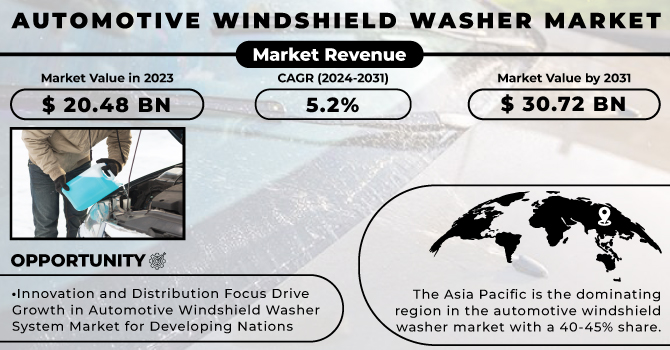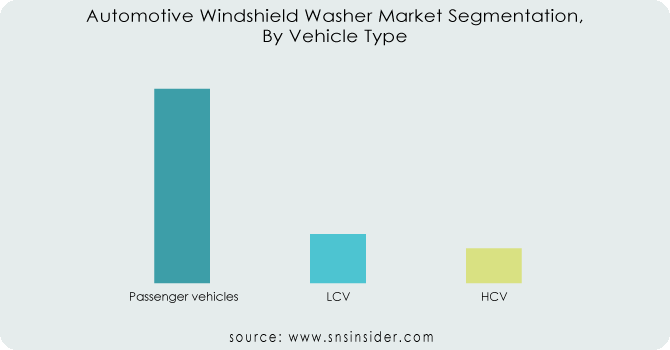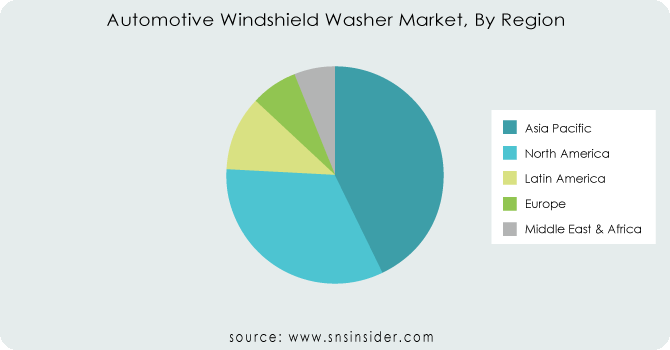Automotive Windshield Washer Market Report Scope & Overview:
The Automotive Windshield Washer Market Size was valued at USD 20.48 billion in 2023 and is expected to reach USD 30.72 billion by 2031 and grow at a CAGR of 5.2% over the forecast period 2024-2031.
Essential for secure driving, windshield washer fluid plays a vital part in keeping up clear visibility through all climate conditions. This extraordinarily defined fluid, often containing a mix of denatured alcohol, detergents, colorants, and even fragrances, acts in conjunction with the windshield wiper system to effectively remove dirt, dust, and even snow.

Get More Information on Automotive Windshield Washer Market - Request Sample Report
The market for this vital fluid is balanced for significant growth in the coming a long time, fueled by two the components like the increasing demand for its use in vehicles and a growing consumer focus on maintaining their cars, particularly the windshields. This development is assist supported by the availability of various washer fluid formulations, each catering to particular needs and climate conditions. The washer fluid system itself is a well-coordinated network comprising of a reservoir, pump, hoses, and nozzles, working consistently to provide the liquid onto the windshield for ideal cleaning, ensuring a safe and clear driving experience.
MARKET DYNAMICS:
KEY DRIVERS:
-
Surging Commercial Vehicle Sales Drive Growth in Automotive Windshield Washer System Market
The recent surge in commercial vehicle sales has created demand for windshield washer systems. This drift is anticipated to move the development of the car windshield washer system market, as more commercial vehicles require these systems for keeping up clean windshields and ensuring optimal visibility on the road. This development is fueled by the expanded dependence on commercial vehicles for transportation, driving to a more prominent require for their upkeep and maintenance.
-
High-Performance Vehicles and Consumer Desire for Enhanced Visibility Drive Automotive Windshield Washer System Market Growth.
RESTRAINTS:
-
High Production Costs Limit Market Growth for Automotive Windshield Washer Fluids
OPPORTUNITIES:
-
Innovation and Distribution Focus Drive Growth in Automotive Windshield Washer System Market for Developing Nations
Manufacturers in the automotive windshield washer system market are actively innovating to cater to diverse consumer needs. This includes developing application-specific products that address various driving conditions and preferences. Additionally, a strong focus on improving distribution networks ensures wider availability and accessibility of these systems. This combined effort is particularly relevant for developing nations where a growing population and expanding economies are driving the demand for automobiles, leading to a heightened need for efficient windshield washer systems.
-
Rain-Sensing Wiper Systems Gain Traction in Mid-Sized Cars, Powered by IoT and Collaboration with Automakers
CHALLENGES
-
High Setup Costs and Short Lifespan of Systems Potentially Hinder Automotive Windshield Washer System Market Growth.
IMPACT OF RUSSIA-UKRAINE WAR
The ongoing conflict between Russia and Ukraine has disrupted the automotive windshield washer system market by causing a 5-7% decline in its growth trajectory. Factory closures and production halts due to parts shortages and supply chain disruptions, particularly in Europe, have directly impacted the demand for new windshield washer systems installed in vehicles. The war has triggered a significant price surge in nickel, a key component for stainless steel used in washer system components. This translates to higher production costs for manufacturers, potentially leading to increased consumer prices and dampening demand. Thus, the economic fallout from the war has shifted consumer spending priorities. With rising inflation and uncertainty, individuals are likely to prioritize essential expenses over non-critical car maintenance like replacing windshield washer fluid or upgrading the system, further hindering market growth.
IMPACT OF ECONOMIC SLOWDOWN
The economic downturn leads cause to the automotive windshield washer system market at 3-5% decline in the market growth. This slowdown primarily stems from reduced new car sales. As consumers limit their budgets and prioritize essential spending, discretionary purchases like new vehicles take a backseat. This directly translates to a diminished demand for pre-installed windshield washer systems in new cars. The economic uncertainty often leads individuals to postpone non-critical car maintenance, including replacing windshield washer fluid or upgrading the system. This shift in consumer spending behaviour results in a temporary decrease in demand for aftermarket washer fluid and system components. The declining disposable income levels during economic slowdowns impact consumer purchasing power. This can lead individuals to seek cheaper alternatives for windshield washer fluid or even delay purchases altogether. However, it's crucial to remember that the windshield washer system holds a unique position within the automotive industry.
KEY MARKET SEGMENTS:
By Fluid Type:
-
Bug-Repellent
-
Water-Repellent
-
Anti-Freeze
-
Others
Water-Repellent Windshield Washer Fluid is the dominating sub-segment in the Automotive Windshield Washer Market by fluid type holding about 60-65% of market share. Water-repellent washer fluid offers superior visibility during rain and snow by creating a water-beading effect on the windshield, improving safety and driving experience. This makes it the most popular choice for consumers.
By Vehicle Type:
-
Passenger vehicles
-
LCV
-
HCV
Passenger Vehicles is the dominating sub-segment in the Automotive Windshield Washer Market by vehicle type holding about 70-75% of market share. Passenger vehicles constitute the vast majority of vehicles on the road, leading to a higher demand for windshield washer systems

Get Customized Report as per your Business Requirement - Request For Customized Report
By Application:
-
OEM
-
Aftermarket
Aftermarket is the dominating sub-segment in the Automotive Windshield Washer Market by application holding about 65-70% of market share. The aftermarket segment caters to existing vehicles, encompassing replacement washer fluid purchases, system repairs, and upgrades. This segment benefits from the large installed base of vehicles and the need for regular maintenance and fluid refills.
REGIONAL ANALYSES
The Asia Pacific is the dominating region in the automotive windshield washer market with a 40-45% share. This dominance stems from its booming automotive industry, particularly in China and India, leading to a massive number of vehicles on the road and a high demand for both washer systems and fluids. Additionally, the region boasts a flourishing aftermarket sector catering to the existing vehicle base, further solidifying its leadership position. North America is the second highest region in the market with a 30-35% share, its well-established automotive industry, strong aftermarket presence, and high consumer awareness regarding car care contribute significantly to its market size.

REGIONAL COVERAGE
North America
-
US
-
Canada
-
Mexico
Europe
-
Eastern Europe
-
Poland
-
Romania
-
Hungary
-
Turkey
-
Rest of Eastern Europe
-
-
Western Europe
-
Germany
-
France
-
UK
-
Italy
-
Spain
-
Netherlands
-
Switzerland
-
Austria
-
Rest of Western Europe
-
Asia Pacific
-
China
-
India
-
Japan
-
South Korea
-
Vietnam
-
Singapore
-
Australia
-
Rest of Asia Pacific
Middle East & Africa
-
Middle East
-
UAE
-
Egypt
-
Saudi Arabia
-
Qatar
-
Rest of Middle East
-
-
Africa
-
Nigeria
-
South Africa
-
Rest of Africa
-
Latin America
-
Brazil
-
Argentina
-
Colombia
-
Rest of Latin America
KEY PLAYERS:
The major key players are General Motors, Lincoln Aviator, 3M (U.S.), ITW Global Brands (U.S.), Guangzhou Botny Chemical Co., Ltd. (China), Sonax GmbH (Germany), Qwix Mix (U.S.), Total (France), Recochem Inc. (Canada), ACDelco (U.S.), Prestone Products Corporation (U.S.), Soft99 Corporation (Japan), Japan Chemical Industries (Japan) and other key players.
General Motors-Company Financial Analysis

RECENT DEVELOPMENTS:
-
In March 2022 - StradVision and ZF partnered to boost automated driving software offerings. StradVision's SVNet software tackles object detection in challenging conditions and optimizes sensor integration for shuttles and vehicle electrical systems. This collaboration expands both companies' automated driving perception technology portfolios.
| Report Attributes | Details |
|---|---|
| Market Size in 2023 | US$ 2.48 Billion |
| Market Size by 2031 | US$ 3.72 Billion |
| CAGR | CAGR of 5.2% From 2024 to 2031 |
| Base Year | 2023 |
| Forecast Period | 2024-2031 |
| Historical Data | 2020-2022 |
| Report Scope & Coverage | Market Size, Segments Analysis, Competitive Landscape, Regional Analysis, DROC & SWOT Analysis, Forecast Outlook |
| Key Segments | • by Fluid Type (Bug-Repellent, Water-Repellent, Anti-Freeze, Others) • by Vehicle Type (Passenger vehicles, LCV, HCV) • by Application (OEM, Aftermarket) |
| Regional Analysis/Coverage | North America (US, Canada, Mexico), Europe (Eastern Europe [Poland, Romania, Hungary, Turkey, Rest of Eastern Europe] Western Europe] Germany, France, UK, Italy, Spain, Netherlands, Switzerland, Austria, Rest of Western Europe]), Asia Pacific (China, India, Japan, South Korea, Vietnam, Singapore, Australia, Rest of Asia Pacific), Middle East & Africa (Middle East [UAE, Egypt, Saudi Arabia, Qatar, Rest of Middle East], Africa [Nigeria, South Africa, Rest of Africa], Latin America (Brazil, Argentina, Colombia Rest of Latin America |
| Company Profiles | General Motors, Lincoln Aviator, 3M (U.S.), ITW Global Brands (U.S.), Guangzhou Botny Chemical Co., Ltd. (China), Sonax GmbH (Germany), Qwix Mix (U.S.), Total (France), Recochem Inc. (Canada), ACDelco (U.S.), Prestone Products Corporation (U.S.), Soft99 Corporation (Japan), and Japan Chemical Industries (Japan) |
| Key Drivers | •Glass technology advancements, as well as light flow control, might have an impact on the market. •Larger windshield screens in electric and hybrid automobiles could help accelerate industry growth. |
| RESTRAINTS | •The high costs of windshield washer formulae may prevent the market from growing. •Companies' premiumization of windshield cleaning fluid in order to appeal to all demographics.+D25 |

